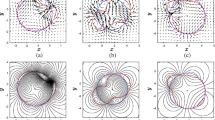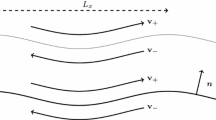Abstract
The Biot–Savart law is used in aerodynamic theory to calculate the velocity induced by curved vortex lines. Explicit formulas are developed, using multivariate Appell hypergeometric functions, for the velocity induced by a general parabolic vortex segment. The formulas are derived by constructing a particular pencil of elliptic curves whose period integrals provide the solution to the induced velocity. We use numerical integration and a perturbation expansion to evaluate the validity of our formulas.





Similar content being viewed by others
References
A numerical lifting-line method using horseshoe vortex sheets (May 2011)
Anderson, J.D.: Fundamentals of Aerodynamics, 5th edn. McGraw-Hill, New York (2011)
Beyer, F., Matha, D., Sebastian, T., Lackner, M.: Development, validation and application of a curved vortex filament model for free vortex wake analysis of floating offshore wind turbines. In: 50th AIAA Aerospace Sciences Meeting Including the New Horizons Forum and Aerospace Exposition (Jan. 2012)
Bhagwat, M.J., Leishman, J.G.: Self-induced velocity of a vortex ring using straight-line segmentation. J. Am. Helicopter Soc. 59, 1–7 (2014). https://doi.org/10.4050/JAHS.59.012004
Bliss, D.B., Teske, M.E., Quackenbush, T.R.: A new methodology for free wake analysis using curved vortex elements. Technical Report NASA-CR-3958, NASA (1987)
Brown, J.W., Churchill, R.V.: Complex Variables and Applications, 8th edn. McGraw-Hill, New York (2009)
Elliptic integrals: symmetry and symbolic integration, Turin (Dec. 1997)
Govindarajan, B.M., Leishman, J.G.: Curvature corrections to improve the accuracy of free-vortex methods. J. Aircr. 53(2), 378–386 (2016). https://doi.org/10.2514/1.C033392
Gradshteyn, I.S., Ryzhik, I.M.: Table of Integrals, Series, and Products, 8th edn. Academic Press, Oxford (2014)
Gupta, S., Leishman, J.G.: Accuracy of the induced velocity from helicoidal wake vortices using straight-line segmentation. AIAA J. 43(1), 29–40 (2005). https://doi.org/10.2514/1.1213
Kim, C.-J., Park, S.H., Sung, S.K., Jung, S.-N.: Dynamic modeling and analysis of vortex filament motion using a novel curve-fitting method. Chin. J. Aeronaut. 29(1), 5–65 (2016). https://doi.org/10.1016/j.cja.2015.12.019
Kodaira, K.: On compact complex analytic surfaces, I. Ann. Math. 71(1), 111–152 (1960). https://doi.org/10.2307/1969881
Kodaira, K.: On compact analytic surfaces: II. Ann. Math. 77(3), 563–626 (1963). https://doi.org/10.2307/1970131
Kodaira, K.: On compact analytic surfaces: III. Ann. Math. 78(1), 1–40 (1963). https://doi.org/10.2307/1970500
Kuchemann, D.: A simple method for calculating the span and chordwise loading on straight and swept wings of any given aspect ratio at subsonic speeds. Technical Report 2935, Ministry of Supply Aeronautical Research Council (1956)
Kuchemann, D.: The Aerodynamic Design of Aircraft, 1st edn. Pergamon Press Ltd, Oxford (1978)
Kuchemann, D., Weber, J.: The subsonic flow past swept wings at zero lift without and with body. Technical Report 2908, Ministry of Supply Aeronautical Research Council (1953)
Kundu, P.K., Cohen, I.M., Dowling, D.R.: Fluid Mechanics, 5th edn. Academic Press, Oxford (2012)
Montgomery, Z., Hunsaker, D.F.: A propeller model based on a modern numerical lifting-line algorithm with an iterative semi-free wake solver. AIAA Scitech Forum (2018). https://doi.org/10.2514/6.2018-1264
Nagati, M.G., Iversen, J.D., Vogel, J.M.: Vortex sheet modeling with curved higher-order panels. J. Aircr. 24(11), 776–782 (1987). https://doi.org/10.2514/3.45520
Phillips, W.F., Snyder, D.O.: Modern adaptation of Prandtl’s classic lifting-line theory. J. Aircr. 37(4), 662–670 (2000). https://doi.org/10.2514/2.2649
Phillips, W.F.: Mechanics of Flight, 2nd edn. Wiley, Berlin (2010)
Semi-empirical vortex step method for the lift and induced drag loading of 2D or 3D wings, California (Oct. 1997)
Van Hoydonck, W., Gerritsma, M., van Tooren, M.: On core and curvature corrections used in straight-line vortex filament methods (Apr. 2012). arXiv:1204.2699
Weissinger, J.: The lift distribution of swept-back wings. Technical Report 1120, NACA (1947)
Wood, D.H., Li, D.: Assessment of the accuracy of representing a helical vortex by straight segments. AIAA J. 40(4), 647–651 (2002). https://doi.org/10.2514/2.1721
Yoon, S.S., Heister, S.D.: Analytical formulas for the velocity field induced by an infinitely thin vortex ring. Int. J. Numer. Methods Fluids 44(6), 665–672 (2004). https://doi.org/10.1002/fld.666
Acknowledgements
Funding was provided by Simons Foundation (Grant No. 202367).
Author information
Authors and Affiliations
Corresponding author
Additional information
Publisher's Note
Springer Nature remains neutral with regard to jurisdictional claims in published maps and institutional affiliations.
Rights and permissions
About this article
Cite this article
Malmendier, A., Reid, J.T. Application of the Biot–Savart law to parabolic vortex segments using elliptic integrals. Z. Angew. Math. Phys. 71, 104 (2020). https://doi.org/10.1007/s00033-020-01319-3
Received:
Revised:
Published:
DOI: https://doi.org/10.1007/s00033-020-01319-3




